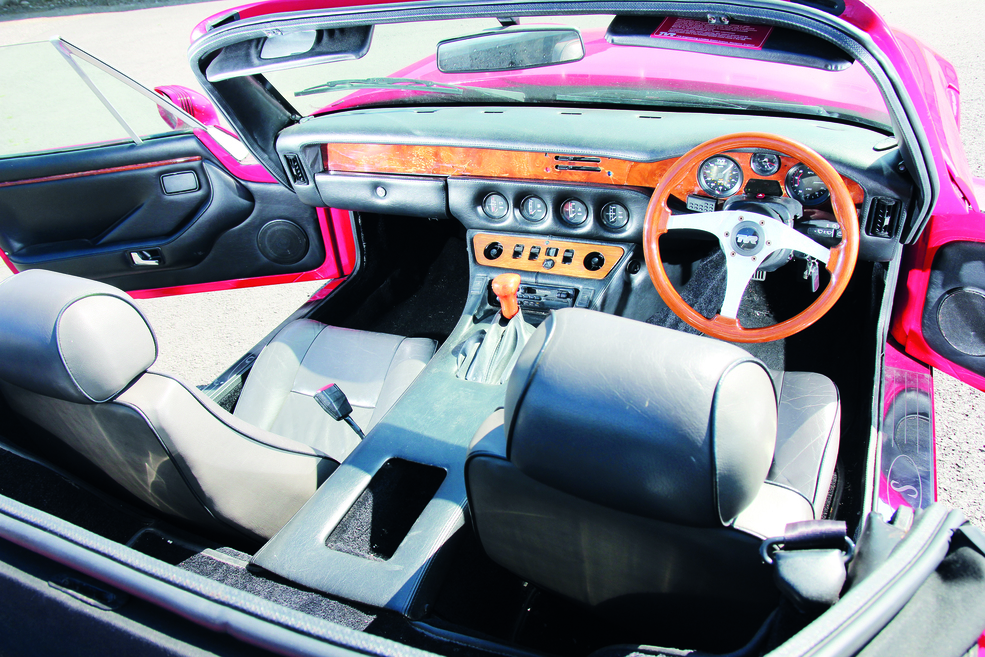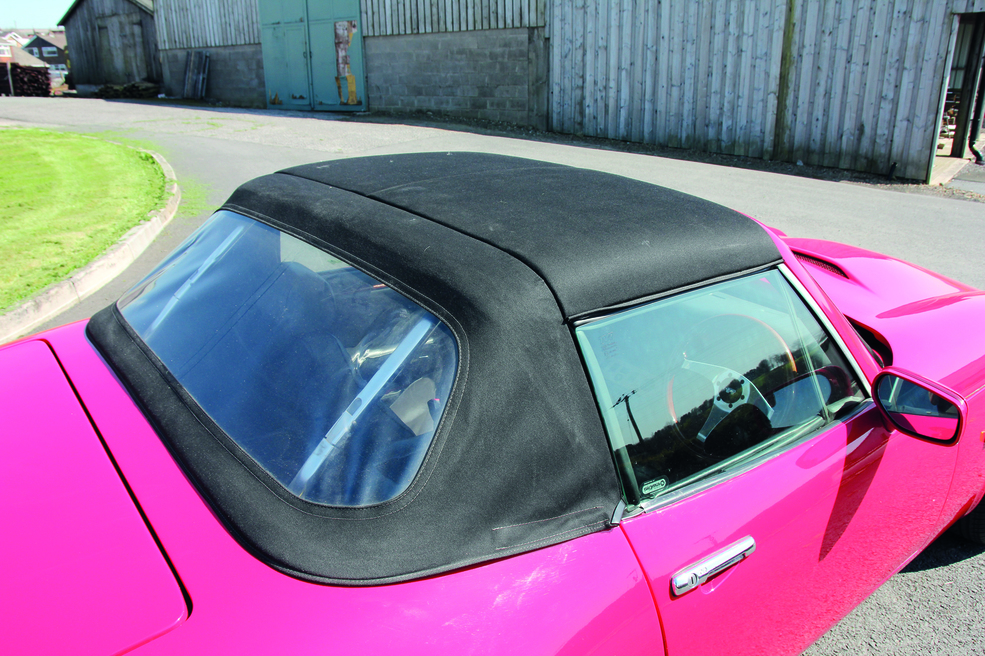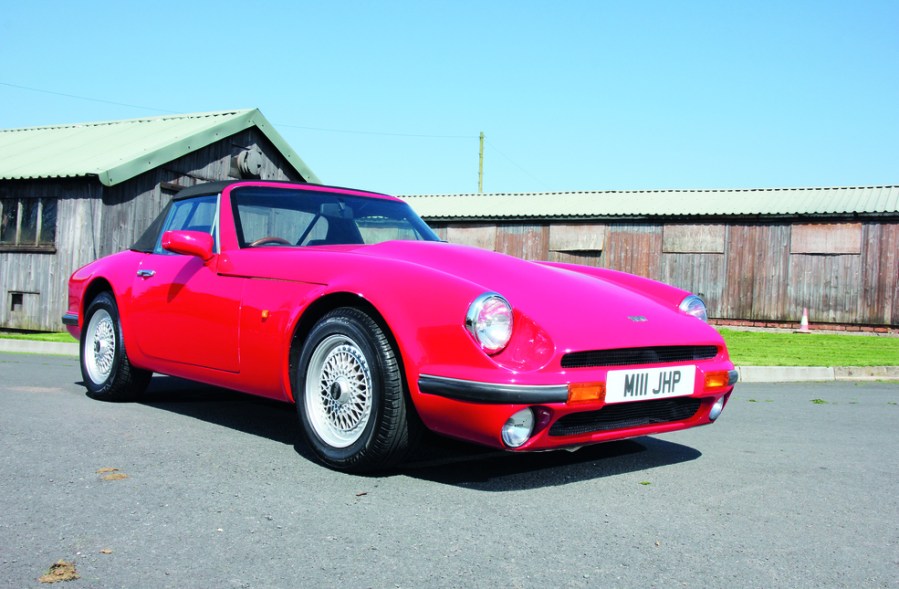TVR’s return to the rounder shape that was so successful in the M-series of the ’70s was launched in 1986 alongside the popular wedgy Tasmins. The TVR S as it was known, was initially powered by Ford’s 2.8-litre V6 engine that was fitted to the Capri and Granada. This engine gained an extra 155cc (2778cc up to 2933cc), with an additional 8bhp and 29lbf.ft of torque when Ford moved onto the 2.9-litre V6, forcing TVR to do the same and launch the series two in 1988 (known as the TVR S2).
The following year, the S3 appeared with several revisions and in 1991, the S4 was launched with even more improvements. Sales of the TVR S were healthy, with a total of 2192 Ford V6 cars being sold. At the time, there wasn’t much choice for a high-performance two-seater sports car. The Mazda MX-5 and Toyota MR2 were the main contenders, along with the promised MG RV8 that eventually appeared in 1992.
Whilst the Ford-powered TVR S was seemingly successful, there was always the potential for more performance. The Tasmins had adopted the Ford V6, but had moved onto the Rover V8, so it seemed sensible to do the same with the TVR S. The first V8-powered S appeared in 1990, and production figures state that a total of 408 were built up to 1994 when the S finished and the likes of the Griffith and Chimera took over.

On paper, The V8 S was noticeably better than the Ford powered model. A 3.9-litre version of the ex-Buick all-aluminium engine was adopted, but equipped with gas-flowed cylinder heads, a high-lift camshaft and quoted a compression ratio of 10.5:1. With a revised engine management system and a limited slip differential, power output was 240 bhp in comparison to 168 bhp from the V6; torque was 270 lbf.ft, whereas the V6 offered 191 lbf.ft and the 0-60mph time was two seconds quicker than the V6 at 4.9 seconds. At the time, its acceleration from standing to 60 mph was a match for a Ferrari Testarossa.
Under the skin, the V8 S retained the same front double wishbone suspension set-up and rear trailing arm assembly, but with a slightly wider track, and disc brakes all round, whereas the V6 cars had drum brakes on the rear.
There are a few cosmetic differences on the V8 model. There’s a hump in the bonnet, which was designed in anticipation of fitting a supercharger, although only a couple of supercharged V8 S models were manufactured. The standard specification included half-leather interior trim, a walnut dashboard, mohair hood, OZ alloy wheels, driving lamps and electric door mirrors and windows. However, optional extras may mean some V8 S models are different.

The car photographed here is possibly one of the last examples to be manufactured, having been registered on the August 1, 1994. It still has its original-specification OZ wheels that were supposedly fitted to all V8 models, along with the bonnet hump. Raise the forward-hinging bonnet and the Rover V8 sits neatly in the chassis, tucked back from the front wheels to help keep the weight balance in the centre. It’s mated to a five-speed LT77 gearbox (as used on early Griffiths) that’s hidden under the dashboard and centre tunnel, resulting in a traditionally large centre console and a wide division between driver and passenger.
The interior is a tasteful blend of leather and walnut with TVR-badged instruments. The hood is a clever design and a credit to TVR from an era when the mainstream manufacturers had only just perfected the art of an easy-to-operate framework. In the TVR’s case, the hood consists of two roof sections (targa panels) and a rear section. There are two rear struts that need to be collapsed to take the tension off the rear section, allowing the two roof panels to be unclipped and removed. If desired, those two rear struts can be pushed back into position to tension the rear section. Otherwise, they can be fully collapsed and the rear of the hood folded down.

The two roof panels can be stored in the boot, which is opened electronically via a switch under the dashboard. With the battery stored inside the boot, the release cable appears to be traceable into the interior, so hopefully a flat battery wouldn’t be such a disaster.
There’s no mistaking the sound of a V8 and this TVR doesn’t disappoint. The first twist of the ignition key switches on the fuel pump and it can be heard ticking away behind you. The next twist powers the starter motor and it’s not long before all eight cylinders have burst into life. The underslung twin exhaust system burbles from the back and you’re ready to start working the gear lever. Reverse is a case of lifting the stick and finding an extended first, whereas all five of the forward gears are in a traditional pattern.
Once on the move, this TVR feels in many ways like a typical V8-powered open-top two-seater sports car. It’s not as wallowy as an older MGB GTV8, but not as refined as a later MG RV8 or TVR Chimera. This is certainly a driver’s car that should belong to someone who’s proud to own a piece of British motoring history. Needless to say, a sympathetic approach to build quality is required, which is what most classic car owners have come to accept with any car that is old enough to have developed some common problems.

On this car for instance, the bottom of the doors don’t sit flush to the bodywork, and it may be more hassle than it’s worth to tweak and align them; the driver’s electric window wasn’t working, some of the trim needed refurbishing and there were several panel rattles when driving the car. Some of these problems can be fixed, but some are just part and parcel of the TVR experience.
The TVR V8 S clearly offers more performance than a Ford V6 powered model, although Ford fans could argue that few classic TVR owners are going to realise the benefit of the extra 72 bhp and the two seconds shaved off the 0-6 0mph time. Instead, if you’re a fan of vee-configuration engines, then a V8 in a TVR is in many people’s opinion, the engine to have. It’s like choosing between a V6 and V8-powered replica of an AC Cobra. The V6 will undoubtedly be sufficient, but the extra two cylinders seem to matter.
We came away smitten by the TVR V8 S that’s for sale at AH Classic Cars. Proprietor Andrew Henson has owned four of them and appreciates them for what they are; they’re not the most expensive of the V8-powered classic sports cars (at £13,500 for this one, you’ll be hard pushed to find an equivalent MG RV8), they’re not as refined as similar cars, but that’s maybe the challenge of owning one.








